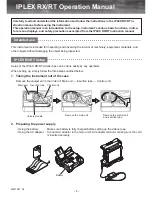
Heinrichs Messtechnik
TSK1 Installation and Operating Instructions
Page 7 of 27
vertical: from the top to the bottom
vertical: from the bottom to the top
Caution:
When mounting the device in the horizontal position, make
sure the indicator unit is not pointing upwards. This is to
prevent water lodging on the glass window and entering the
device under the protective shroud of the housing.
7.1.1
Mounting/start-up
Before installation, check whether the measuring element is
free from foreign bodies. The instrument must be mounted
perpendicularly or horizontally according the planned and
confirmed direction of flow.
The nominal size of the device and that of the pipes must be
the same. The pressure stages and, hence, the dimensions
of the flanges must coincide. The surface roughness of the
flange sealing surface must be suitable for the prescribed
gaskets.
Check whether the mounting clearance between the flanges
of the pipes corresponds to the assembly dimension of the
device plus two gaskets. To achieve stress-free mounting,
the flanges of the pipes must be aligned parallel to each
other.
If the device is calibrated to more than 1.013 bars absolute
pressure, the valve is usually installed behind the flowmeter.
At 1.013 bars absolute pressure (free exhaust) install it in
front of the device.
Device slowly flush to avoid a surge of gas bubbles.
Basically, avoid activation using solenoid valves.
Use connecting bolts and gaskets in the prescribed
dimensions. The gaskets must be suitable for the operating
pressure, the temperature and the measured medium. With
PTFE- and PP coated devices, use gaskets whose interior
and exterior diameter correspond to the sealing strip of the
device.
Tighten the flange bolts crosswise so that the process
connections are tight. Pay particular attention to the
tightening torques of screws, especially with PTFE- and PP-
coated devices. The maximum torques are:
Nominal size
Nominal
pressure
Tightening
torques
DN50 / 2“ ANSI
PN 40
45 Nm
DN65
PN40
45 Nm
DN80 / 3“ ANSI
PN 40
48 Nm
DN100 / 4“ ANSI
PN 16
50 Nm
DN125 / 5“ ANSI
PN 16
80 Nm
DN150 / 6“ ANSI
PN 16
90 Nm
DN200 / 8“ ANSI
PN 10
115 Nm
DN250 / 10“ ANSI
PN 10
95 Nm
DN300
PN 10
115 Nm
DN350
PN 10
140 Nm
DN400
PN 10
155 Nm
(following VDI/VDE Guideline 3513)
Please check whether the pipe is adequately stable so that
vibration or swinging of the device is out of the question.
(Do not use steel mounting parts directly on the device.)
7.1.2
Device settings
The measuring equipment is delivered ready for operation
according to your order specifications.
The limit
transducers
are set to the desired values. If you have
submitted no requirements, the basic setting for
1 contact device: - Minimum contact switching point at 20%
of descending flow (damped/closed-circuit principle).
2 contact devices: Minimum contact switching point at 20%
of descending flow and maximum contact switching point at
90% of ascending flow
7.1.3
Adjusting the limit transducer
The contacts are adjustable through the contact position
indicators located on the scale. Dismantle the indicator
cover, unfasten the contact position indicators, set to the
desired value and reattach them.
Summary of Contents for Heinrichs TSK
Page 1: ...Paddle Type Flowmeter for Liquids TSK Installation and Operating Instructions ...
Page 23: ...Heinrichs Messtechnik TSK1 Installation and Operating Instructions Page 23 of 27 ...
Page 24: ...Heinrichs Messtechnik TSK1 Installation and Operating Instructions Page 24 of 27 ...
Page 25: ...Heinrichs Messtechnik TSK1 Installation and Operating Instructions Page 25 of 27 ...
Page 26: ...Heinrichs Messtechnik TSK1 Installation and Operating Instructions Page 26 of 27 ...








































